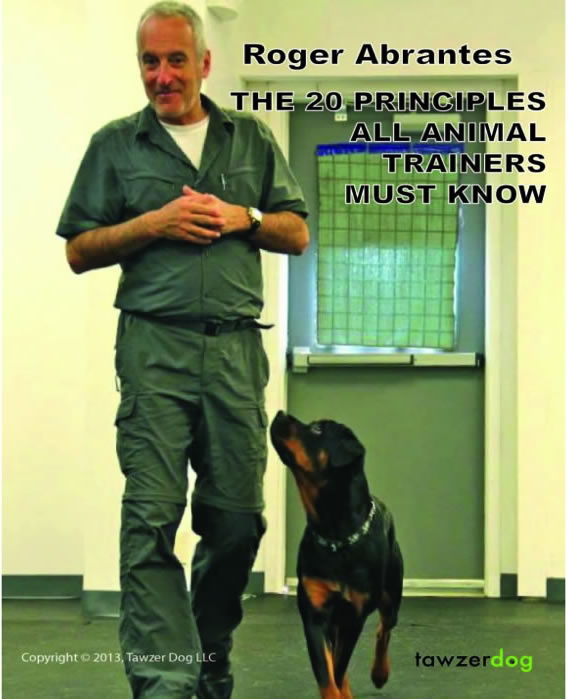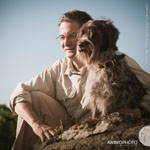| Français |
Roger Abrantes, PhD
The 20 Principles All Animal
Trainers Must Know
DVD
http://www.dogwise.com/itemdetails.cfm?ID=DTB1328
 |
Roger Abrantes has a PhD in Evolutionary Biology and Ethology, and BA in Philosophy, is the scientific director of the Ethology Institute Cambridge, special advisor for the GNR, instructor at the CNCA (California Narcotics Canine Association) and the author of many books and articles on animal behavior and learning and lectures in Ethology, Evolution, Learning Theory, Animal Training and Critical Reasoning. He instructed the trainers of the famous Hero Rats that detect landmines and tuberculosis in Africa.
In this series of 3 DVDs of nearly 6 hours, Abrantes explains the 20 principles all animals trainers must know. Being a scientist, Abrantes bases those principles on animal learning scientific knowledge.
To this formal presentation, he adds many example using dog/master teams that he does not know and corrects diverse obedience and attention problems. Those demonstrations are interesting because we learn subtleties of communication, but maybe a bit repeating.
He thinks that dog handlers went a bit too far using operant conditioning : they forgot the importance of the relationship. So, in this workshop, he uses rarely food treats as positive reinforcement but he emphasizes communication and relationship with the dog.
For sure he uses operant conditioning but he adds non-verbal communication based on canid’s one. Take note that books, DVDs or workshops rarely cover communication and relationship. He use subtle communication and dogs rapidly grow much fun working with him. He is also a great observer and he teaches us to detect subtle causes of behaviors.
Methodical, he first defines the concepts; he explains that a tool is not dangerous in itself, but it can be if it is misused. A hammer is useful but it can be dangerous if mishandled: just have hit on the run to be convinced. Abrantes informs us that positive reinforcement is often fatal: a lot of dogs are euthanized because of unacceptable behaviors (barking, biting, etc.) that were caused by positive reinforcement misused by his humans.
Abrantes reminds us that it is what follows a behavior that has the effect of increasing or reducing this behavior frequency, duration and / or intensity.
A stimulus following a behaviour that increases is qualified as "positive reinforcer".
To increase or reduce a behaviour :
|
If the behavior increases |
If the behavior decreases |
If the stimulus |
It is a |
It is a |
If the stimulus is withdrawn |
It is a |
It is a |
Note that he renamed "inhibitor" what is usually called "punishment" in the literature. He made this choice because the word has a pejorative meaning and is emotively charged. The term "inhibitor" does not posses this negative and emotional aura.
If we add a stimulus, it is described as "positive" if it is removed, it is called "negative." Abrantes said that "negative" or "positive" are not value judgments toward these stimuli: these words only specify if the stimuli is added or withdrawn. It is also very important to note that a stimulus will be a reinforcer or an inhibitor for that given animal at this moment in this particular circumstance.
We have to understand that it is the animal that decides if it is a reinforcer or an inhibitor. For example, a given stimulus, which usually has the effect of increasing a behavior, thus reinforcing a behavior in these circumstances with this animal, can, on an another occasion have no effect, thus, it is not a reinforcer in those circumstances. (eg the animal is no longer hungry, sick, scared, etc.). Therefore, a stimulus is not inherently a reinforcer or an inhibitor.
In addition to using positive reinforcers, Abrantes does not deprive himself of using negative reinforcers, positive inhibitors and negative inhibitors. He specifies that to reduce a behavior, a consequence does not need to be hard or painful for the animal.
As a matter of fact, he says, if consequences are too strong or too weak, whether they are reinforcers or inhibitors, they may not have the desired effect. Each result has what he calls an « window of opportunity » a level which, if it is too low, will have no effect on the behavior and if it is too high will create another behavior than what is desired.
Whatever he says in those DVDs that his text, The 20 Principles All Animals Trainers Must Know, is available on his website, the document is no longer available; it costs a bit to access it online. Note that it is available in English, in French and several other languages.
http://ethology.eu/study-programs/study-resources/books/
Also see his web site (http://ethology.eu/) and his Facebook page (https://www.facebook.com/rogerabrantes?fref=ts)
Note that another of his DVD, Dog Language Seminar, is very interesting. However, despite its title, it deals almost exclusively with non-human verbal communication and very little with canine communication.
http://www.dogwise.com/ItemDetails.cfm?ID=DTB902
His book, Dog Language - An Encyclopedia of Canine Behavior is still a classic.
http://www.amazon.ca/Dog-Language-Encyclopedia-Canine-Behavior/dp/0966048407/ref=sr_1_2?s=books&ie=UTF8&qid=1427389081&sr=1-2&keywords=Roger+abrantes
Louis Cimon
15-03-31
